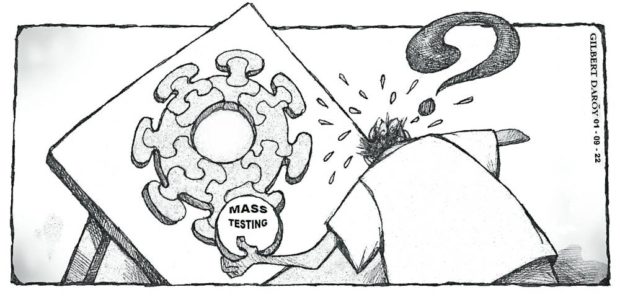Mass testing for crucial data

Year 3 into the pandemic, and calls for mass testing are once again being made given the dramatic rise in new COVID-19 cases. This week, lawmakers demanded anew that mass testing be implemented as new cases surged to almost 22,000 last Friday, breaching the 20,000 mark for the first time since Sept. 26, 2021. But that urgent call is likely to continue to fall on deaf ears. Not only has the administration expressed refusal to conduct mass testing even with the tsunami of new infections, the lawmakers also discovered that Malacañang allotted zero funds to offer free tests under the P5.024 trillion 2022 national budget.
Instead, as House of Representatives deputy minority leader and Bayan Muna Rep. Carlos Isagani Zarate noted, this year’s budget prioritized arms and military equipment procurement. The budget, he decried in a statement, is “not designed to save lives … There is no money for free mass testing for vulnerable persons, essential workers, and employees, but there is money to buy missiles, helicopters and war materiel.”
All the Department of Health (DOH) could do was declare that it was preparing for the “worst-case scenario” as the ICU bed utilization rate reached 48 percent in the National Capital Region (NCR) and 32 percent nationwide. The health secretary said they were prepared to round up health care workers (HCWs) from different sectors, including post-graduate interns and HCWs from the Armed Forces of the Philippines and the Philippine National Police, to help in fighting the virus. With at least P50 billion earmarked for HCWs’ special risk allowances in this year’s budget, there should be no reason for frontliners to see a repeat of last year’s appalling scenario where they had to beg and even march on the streets for the release of the money owed them for work where they risked their and their loved ones’ lives.
As cases continued to rise after the holidays, Metro Manila reverted to alert level 3 last Jan. 3, and as of Jan. 9, 14 more cities and provinces were back under the same stringent restrictions. Metro Manila mayors also issued a directive to prohibit unvaccinated individuals from leaving their homes. But all these measures have not been enough to curb the recent surge in infections. The number of cases still went up even if, as the government claimed, 102 percent of the NCR’s target population already received at least one dose of the COVID-19 vaccine.
The pandemic response, said Gabriela Rep. Arlene Brosas, was “blind to the actual situation on the ground.” More than tightened quarantine measures, the fast-moving situation called for an accurate picture of where the infections are happening and how fast they are spreading so that appropriate containment measures can catch up. That picture can only obtained through widespread testing of the population; without mass testing, experts have emphasized, governments will not have the crucial data to help them stop the virus.
Medical experts have also warned that the number of cases being reported by the DOH does not represent the actual number of infections on the ground, since not everyone having COVID-19 symptoms or have been exposed to the virus are getting themselves tested. To cite just one example: Almost half, or 46 percent, of the people who availed of the Office of the Vice President’s Swab Cab project in Quezon City last Wednesday turned out to be positive for the virus. Many are reluctant to be tested for a simple reason: the prohibitive cost of an RT-PCR test. Add to that the consequences they would have to face if they are found positive of the virus: They would need to isolate for 14 days, something that many—especially those who don’t get paid if they don’t work—cannot afford.
“Since the start of the coronavirus pandemic, the World Health Organization has emphasized the crucial importance of testing,” Anthony Costello, former WHO director of maternal and child health, wrote in The Guardian in March 2020. “Speed is of the essence, and three things are crucial: tracking down cases with symptoms; identifying their household cluster and tracing people they’ve contacted; and quarantining them until they are no longer infectious.” WHO director general Tedros Adhanom Ghebreyesus also said that finding, isolating, testing and treating every case are the only way to break the transmission. “You can’t fight a virus if you don’t know where it is,” he stressed.
The latest word is that the DOH has asked the Food and Drug Administration to approve at-home COVID-19 antigen test kits—something that other countries had made available as far back as 2020, either for free or at affordable cost. As the virus continues to mutate and wreak havoc on the Philippines’ prospects of recovering from the pandemic and its disastrous toll, the Philippines seemingly remains in perpetual catch-up mode.




















